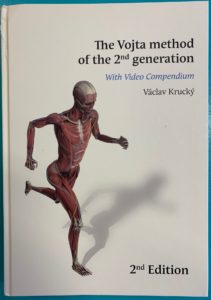 price 1.500,- Kč (e-shop)
price 1.500,- Kč (e-shop)
Book reviews:
Can Vojta Therapy develop further as a theory and technique? May the principles of reflex locomotion formulated by Prof. Vaclav Vojta be also applied to children over twelve months and adults? Are there different ways how to stimulate global muscular activation patterns which may broaden the diagnostic scope of therapeutic interventions? Václav Krucký`s monograph published in 2017 tries to answer some of these questions. A colourful A4 format book contains more than 15 years of author`s clinical experience and in nearly 300 pages concentrates wealth of illustrating pictures, anatomic drawings, video-recordings and animation references.
Detailed case studies (including morbus Perthes of author`s daughter) focus predominantly on clinical aspect, clarity of presentation and practical application of Vojta Therapy. It underlines a perspective of patients and those who assist in sometimes draining practice of reflex locomotion (parents, partners, relatives and domestic therapists). Didactic feature of the whole book helps to understand the principles of Vojta Method of 2nd Generation (VM2G) not only to relatives who assist patients, but can also stimulate students, physiotherapists, physicians and sport coaches. The whole book consists of 14 chapters explaining not only fundamentals of Vojta Therapy and developmental kinesiology, but also significance of central coordination and locomotion regulation and reparative function of motoric programmes. Krucký describes features of Vojta Therapy innovation named Vojta Method of the Second Generation (VM2G), its practical procedures and technical assisting aids.
What does characterise the Krucký`s innovation? A) Conceptual aspect (3 dimensional model of locomotion), B) Emotional aspect (children`s stress and pain are minimised, therapeutic stimulation always respects attachment needs, for example a child`s need to maintain experience of a good and secure representation of parent that does not transform into bad, attacking or non-protective parental object in the course of painful treatment, C) Technical aspect (therapeutic reflex is elicited without painful sensations, manual stimulation of reflex zones is replaced by elastic separators and amplification: using bed incline, multiple stimulation, limb weights, instability provoking aids, adhesive pads and therapeutic suit).
English translation left several obscure formulations from the original Czech manuscript and would benefit from native English speaker editing. VM2G is not an academic work and misses more comprehensive discussion with contemporary publications and current physiotherapeutic procedures based on Vojta Therapy (like dynamic neuromuscular stabilisation of Pavel Kolář), and also more detailed list of references.
However, starting point of VM2G monograph is primarily optimal clinical practice. The author keeps in mind the most effective use of Vojta principles and the maintaining of a cooperative relationship with children and their parents as well. Krucký`s innovations allow for more intense and comfortable stimulation and therefore broadens various treatable conditions beyond central coordination disorder of children under 12 months, but also pre-school children, adults and older-age individuals. Furthermore, this innovation allows to carry out Vojta Therapy in psychosomatic, post-traumatic and post-operative conditions, and also in adult patients who are immobile, or suffer from neurodegenerative, chronic functional musculoskeletal and pain disorders. It is encouraging that also Vojta Therapy implementation shows positive therapeutic response in children suffering from attention deficit and hyperactivity disorder, or even autistic spectrum disorder. Krucký`s book empowers parents and relatives and facilitates their active compliance with long-term and sometimes demanding treatment. They can assume their responsibility for treatment that becomes clear and understandable for them. The book is truly modern due its numerous illustrations but also QR codes (and internet links) that can immediately connect reader with appropriate webpage and show video-recordings. It is worth watching not only longitudinal spontaneous physiological infant`s motoric presentation (developmental trajectories) but also 9 x 120 minutes of authentic historical lectures of Prof. Vojta that were delivered in Prague in 1991.
The name Vojta method of second generation (VM2G) reflects a compromise: is thoroughly based and respects theory and technique of Vojta Therapy, but also explicitly describes and explains methodical innovations. It opens up questions of further development of Vojta Therapy, its identity and boundaries. Vojta did not provide neurological explanation for provoked patterns of reflex locomotion and there are still unresolved issues concerning the theoretical foundation of his method. Krucký`s publication is a clinical attempt to find sensible account for central motoric coordination mechanism that is close to Laufens et al (1991) and Rossignol et al (2006) definitions of the Central Pattern Generator and „dynamic interaction between central program and feedback mechanisms“.
Rich clinical material in the reviewed publication and its methodological innovation encourage to set up a well-designed qualitative study and determine with sufficient evidence effective factors used in Vojta Therapy or its innovations. Such approach goes beyond ideological arguments and preconceptions.
Dr. David Holub, Ph.D.
Institute for Medical Humanities, 1st Medical Faculty Charles University, Prague, Czech Republic
Faculty of Social Studies, Masaryk University, Brno, Czech Republic
Published by SVR – Society for Developmental Rehabilitation, Ostrov, Czech Republic, supported by Norway Grants, 2017, 298 pages. ISBN 978-80-906760-0-8.
Free to view: Angličtina 1 vydání zmenšeno 3